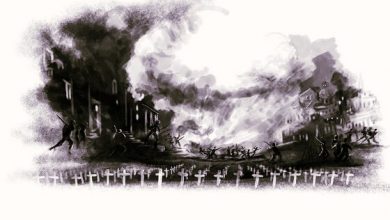Exploring the intricacies of human connections, Segun Afolabi’s short story “Mrs. Mahmood” takes readers on an unforgettable journey through the bustling streets of London. Set in a sports shop, the narrative follows the life of Mr. Mahmood, a sports shop manager, whose seemingly ordinary day takes a dramatic turn when he encounters a young burglar. The themes that the author has delved into are those of urban displacement and cultural clashes, sense of place and identity, struggles with belonging and acceptance, reflection and self-discovery, human reactions to theft and frustration, introspection on personal failures and regrets as well as a longing for a different life or “elsewhere”.
Mrs. Mahmood | Summary
The protagonist, Mr. Mahmood, lives with his wife, Isobel who does not appear as a central character in the story, however, remains the focus. The constant rumbling of the trains beneath their home becomes a comforting and familiar sound for Mr. Mahmood, making him unable to live in a quiet place anymore. Mr. Mahmood’s shop is noisy and hectic just like his home. He takes pride in maintaining a clean and orderly shop and has a keen eye for detail. As the shop’s manager, he values understanding and interaction with customers over focusing solely on business matters.
One day, a young boy comes into the shop with a friend who acts as a decoy. The young boy appears to be a shoplifter as he tries on a pair of Nike running shoes and attempts to escape without paying. Mr. Mahmood notices this and pursues the boy as he leaves the shop. He runs after him through the streets of London, determined to catch him. As Mr. Mahmood chases the young shoplifter, memories of his past resurface. He recalls his youth and athletic abilities, reflecting on a time when he was a promising athlete with high hopes of winning gold medals. However, the pressure to succeed and fear of failure caused him to give up on his dreams, leading to a sense of regret and unfulfilled potential.
The pursuit of the young boy becomes more than just capturing a thief; it becomes a symbol of Mr. Mahmood’s desire to confront his past and overcome his fears of failure. He pushes himself, running with determination and feeling a sense of exhilaration in the process. The boy eventually gives up, and Mr. Mahmood returns to the shop with a sense of accomplishment. Back at home, Mr. Mahmood’s wife, Isobel, comforts him, acknowledging that theft is something one must get used to in their line of work. This triggers a moment of reflection for Mr. Mahmood, where he contemplates his life choices and relationship with Isobel.
The story explores Mr. Mahmood’s feelings of inadequacy, both in his career and personal life. He feels that Isobel’s mother may have had certain expectations of her, which she may not have fulfilled to marry him. However, their love for each other remains steadfast, and they share moments of joy and exploration, venturing to new places together. This short story by Segun Afolabi beautifully captures the essence of human struggles, dreams, and the pursuit of meaning, leaving readers with a profound understanding of Mr. Mahmood’s inner world and the universal themes it embodies.
Mrs. Mahmood | Analysis
The story is set in London, primarily in a sports shop where Mr. Mahmood works as a shop manager. The author creates a vivid and bustling atmosphere in the shop, with a high concentration of stock and busy customers. The constant rumbling of the underground train line also adds to the urban backdrop, providing a sense of familiarity and comfort for Mr. Mahmood. The story is presented in the first-person narrative, providing insights into Mr. Mahmood’s thoughts and emotions. This narrative perspective allows readers to connect deeply with the protagonist and understand his internal conflicts.
The story’s plot centers around a shoplifting incident in the sports shop where Mr. Mahmood works. The young boy’s attempted theft becomes a catalyst for Mr. Mahmood’s introspection and self-discovery. His pursuit of the boy through the busy streets of London symbolizes his desire to confront his past and overcome his fears. The author delves into Mr. Mahmood’s emotions, capturing his sense of inadequacy and longing for something more.
Through his relationship with Isobel, the story portrays moments of joy and connection amidst Mr. Mahmood’s inner struggles. “Mrs. Mahmood” offers readers a reflection on life’s complexities and the impact of past decisions on one’s present. It explores themes of regret, resilience, and the significance of meaningful connections.
Mrs. Mahmood | Themes
One of the central themes in the story is regret and unfulfilled dreams. Mr. Mahmood, the protagonist, used to be an athlete in his youth, breaking county records and dreaming of success. However, his dreams remained unfulfilled, and he now carries a sense of regret for not achieving what he once aspired to. This theme is a poignant exploration of how past decisions and missed opportunities can impact one’s present and shape feelings of inadequacy and longing.
Throughout the narrative, Mr. Mahmood undergoes a journey of self-discovery. The relationship between Mr. Mahmood and his wife, Isobel, is an essential aspect of the story. Their loving and supportive bond serves as a contrast to Mr. Mahmood’s past regrets and fears. Isobel’s presence provides Mr. Mahmood with emotional grounding and stability, emphasizing the significance of meaningful connections in navigating life’s challenges.
The setting of the story in London and the mention of living above an underground train line contribute to the theme of urban life and isolation. The bustling cityscape, noise, and constant movement reflect Mr. Mahmood’s preference for a busy, active environment, seemingly compensating for a fear of silence and stillness. This theme highlights how urban life can both provide comfort and intensify feelings of isolation and disconnection. As the story progresses, Mr. Mahmood’s pursuit of the thief and subsequent introspection leads to a moment of acceptance and contentment. He acknowledges his past regrets and the inevitability of certain life choices, finding a measure of peace within himself.
Mrs. Mahmood | Character Sketch
Mr. Mahmood is depicted as a man haunted by past regrets and unfulfilled dreams of his athletic career. His longing for what could have been is evident in lines such as:
“I hung medals and certificates on the walls at school… I could envisage my life stretching out ahead of me, consisting of adulation and accomplishment in equal measure.”
This sense of regret adds depth to his character and drives his internal conflicts. Despite his regrets, Mrs. Mahmood demonstrates resilience and determination when he foils the shoplifter in the sports shop. His pursuit of the thief reveals his willingness to confront his fears and past failures. The author writes, “I watched impassively. By the time I had reached the door, he was some way down Tottenham Court Road. I started to run.” This determination showcases his strength of character and his willingness to act.
Beneath his external appearance of authority as the shop manager, Mr. Mahmood is shown to be insecure and self-critical. He worries about how others perceive him, especially his staff, who he believes prefer him to be occupied with tasks in the back rather than on the shop floor. He wonders if his meticulousness and attention to order make his colleagues uneasy. The author suggests this internal conflict with lines like, “I don’t know this for certain. I am the manager, I should have mentioned. Perhaps it puts them on edge as if I am constantly watching, scrutinizing.”
Mrs. Mahmood | Literary Devices
The author uses vivid imagery to paint a picture of the settings and scenes, engaging the reader’s senses and creating a more immersive reading experience. For instance, the descriptions of “the 6.25 rumbled beneath our heads,” “the dim, distant thrum of carriages carrying other people elsewhere,” and “warm milky sea” evoke distinct visual and sensory images.
The author employs foreshadowing to hint at future events or developments in the story. One example of foreshadowing is when Mr. Mahmood mentions his tolerance for tranquility being gone, implying that something disruptive or unexpected might happen in the future.
Metaphors are used to convey abstract ideas through comparisons. An example is the metaphorical reference to Mr. Mahmood’s heart sinking when the underground train passes beneath their home, suggesting his feeling of unease or disappointment.
Symbolism is evident in the use of the underground train passing beneath Mr. Mahmood’s home. It can symbolize the constant flow of change, uncertainty, and external influences that affect his life.
The irony is present when Mr. Mahmood, who works in a noisy sports shop, finds comfort in the sound of passing underground trains. It highlights the unexpected and contrasting elements in his life.
The repetition of certain phrases or ideas, such as Mr. Mahmood’s emphasis on maintaining order and cleanliness in the shop or his desire to see customers try on shoes, reinforces his character traits and values.
Mrs. Mahmood | Connection with Another Text by the Author
Segun Afolabi’s short story collection “A Life Elsewhere and Other Stories” contains stories that share similarities with “Mrs. Mahmood” in terms of themes and elements. One story that stands out as having similarities with “Mrs. Mahmood” is “A Life Elsewhere,” which is also the title story of the collection.
In “A Life Elsewhere,” Afolabi examines topics including displacement, cultural identity, and the desire for belonging. Niyi, a Nigerian man who has moved to London in search of a better life, is the story’s protagonist. Niyi finds himself navigating a new environment, dealing with the difficulties of adjusting to a different culture, and looking for a sense of home in a foreign country, just like Mr. Mahmood in the story.
Both stories feature individual journeys of reflection and self-discovery for the characters. They question their identities while also considering their pasts and the decisions they have made in their lives. These pauses for thought and consideration add to the emotional richness of both stories.
In addition, there are parallels between Afolabi’s literary style in “A Life Elsewhere” and his strategy in “Mrs. Mahmood.” He uses first-person narration, evocative imagery, and complex and nuanced characterizations to fully immerse readers in the protagonist’s inner world. Both tales exhibit the author’s skill at capturing the complexity of human emotions and the influence of cultural factors on personal experiences.
This article takes a deep look into Mr. Mahmood and his struggles as well as his insecurities. We understand that Mr. Mahmood is a dedicated man, passionate about his work, and highly conscientious which is evident in his determination to catch the thief. However, Mr. Mahmood almost strikes the boy out of anger which highlights a certain weakness and flaw in his character. He is also consumed with questions about whether he would have struck the boy or not and this becomes an essential moment of introspection which assists Mr. Mahmood in understanding himself. Moreover, his marriage with Isobel seems to be happy, although he does not refrain from counting her flaws. Despite that, the short story is titled “Mrs. Mahmood,” giving Isobel the power of a central character although the readers do not get to peek into the window of her thoughts. Mr. Mahmood’s dependence on his wife and the emotional grounding that he finds in their relationship makes her the central figure in his life.
This summary and analysis of Mrs Mahmood also explores the various themes and literary devices employed in the narrative along with drawing parallels with another one of Afolabi’s works.



